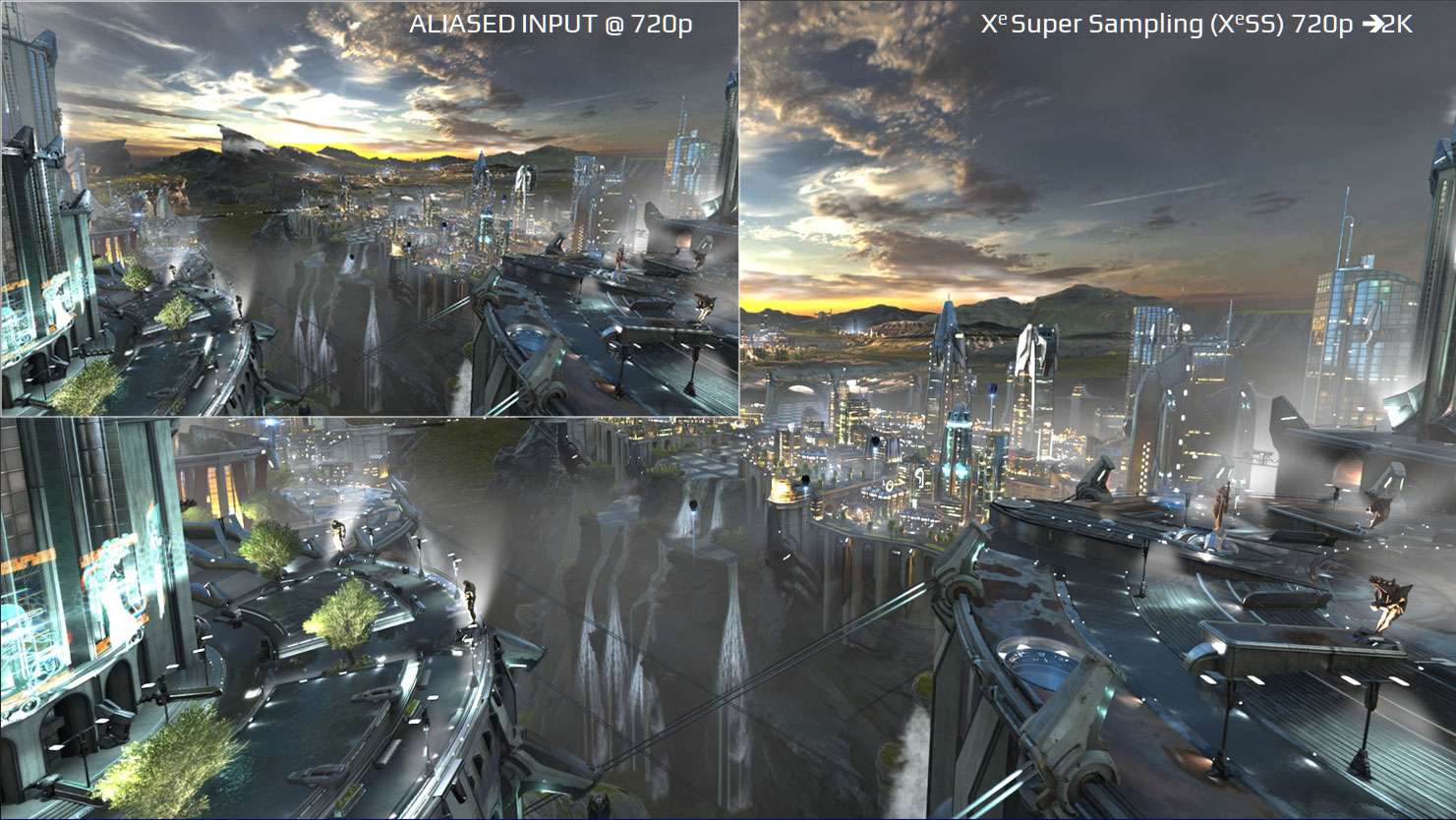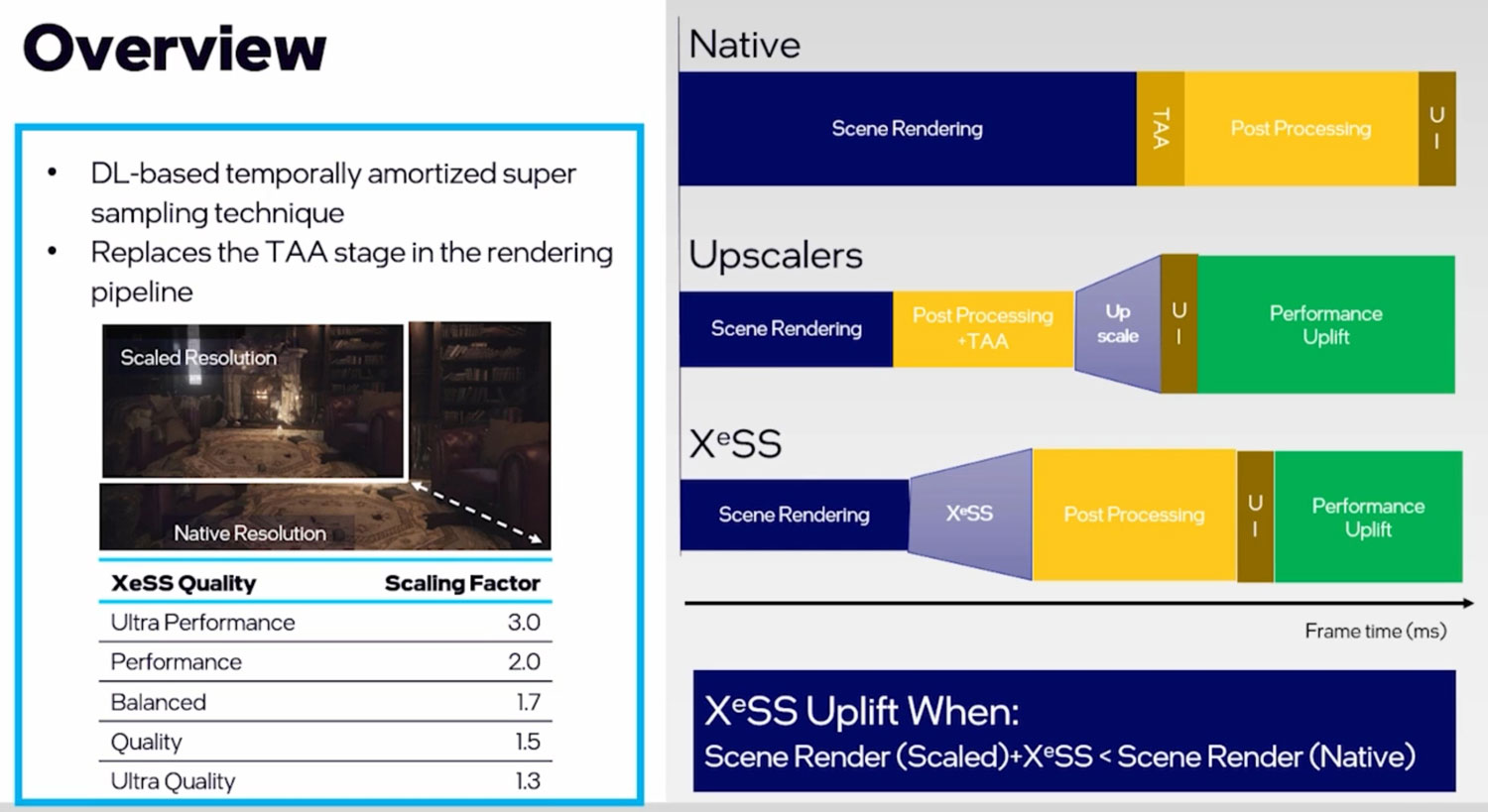Intel Details XeSS Quality Mode With GDC Demos
Intel has numerous sessions at the ongoing GDC 2022.
Intel has shared its Xe Super Sampling (XeSS) video session and presentation deck from this year's Game Developers Conference (GDC) in San Francisco, revealing some new morsels of information among some facts that we already knew. There's also a deep dive into how XeSS works its upscaling magic. Intel execs and developers showed the upscaling tech in action and, of course, provided some comparative performance charts.
Intel hosted several sessions at GDC on Wednesday and there are more scheduled for today. The session we are highlighting here was hosted by Robert Kawiak, a graphics software engineer at Intel. After introducing XeSS and the design decisions behind it, Kawiak looked at some of its appealing qualities vs established and modern rival technologies.
The key thing to remember about Intel XeSS is that it is an AI-based Super Sampling technique for real time rendering that doesn't need per-title training. It is optimized for Xe GPUs in that it will perform best with the Arc Alchemist Xe Matrix Extensions (Intel XMX) but it also runs using DX12 SM6.4+ and DP4a intrinsic support on other GPU architectures. That makes it cross platform and hardware agnostic, and Intel says that the SDK will be open sourced.
In true GDC spirit, Intel focused on how developers can use XeSS. Intel has announced an Unreal Engine plugin for simplified integration of its upscaler into Unreal projects. Intel says that XeSS "substitutes TAA in the rendering pipeline," in projects, so it applies after raster and lighting is complete and should be inserted at the beginning of the post-processing stage.
We hear that Intel's AI alleviates the effects of ghosting, shimmer and blurring that are present in temporal anti-aliasing upsampling (TAAU). Moreover, Intel asserts that its XeSS can achieve higher scaling ratios than modern rivals like AMD FSR or Nvidia DLSS.
Performance Indicators
As with any upscaler, the whole point is to reduce strain on the pixel pipeline to allow fast frame rates at high resolutions. The trick is to do this while still maintaining image quality.
The middle portion of the presentation included developers from Massive Work Studio playing their own new XeSS implemented Rens game and commenting on the graphics and performance you can see on screen. Some portions of this coverage include split screen action with 1080p on one side and 4K XeSS on the other. Intel's video plays back at a maximum 1028p, however, which means we can't get a true look at it.
Get Tom's Hardware's best news and in-depth reviews, straight to your inbox.
The XeSS Rens demo tested various upscale factors, which you can see in more detail in the chart below. The five quality settings were tested running Rens at 2160p and 1440p.
XeSS Quality Levels
A common feature of the AMD and Nvidia's rival technologies is that they offer multiple quality modes, altering the balance between upscaling quality and performance.
Today, Intel revealed its own five quality levels: Ultra Performance (up to 3.0x scaling factor), Performance (2.0), Balanced (1.7), Quality (1.5), and Ultra Quality (1.3). At 4K, the scaling factor tallied quite closely with the relative frame rate performance increase you should expect in this game. In other words, a scaling factor of 2 would more or less double the observed frame rate in XeSS. This isn't a precise rule, and would vary by game and other variables.
Later today Intel has a GDC session about XeSS being implemented in The Riftbreaker.
At the time of writing we don't have an ETA for the launch of XeSS or any games that will work with this new upscaler. The official launch of Intel Arc Alchemist (Mobile) is due next Wednesday however, and Intel might update us at that time.

Mark Tyson is a news editor at Tom's Hardware. He enjoys covering the full breadth of PC tech; from business and semiconductor design to products approaching the edge of reason.
-
tennis2 ReplyThe key thing to remember about Intel XeSS is that it is an AI-based Super Sampling technique for real time rendering that doesn't need per-title training.
This suggests is a driver-level implementation? (ie RSR)
At the time of writing we don't have an ETA for the launch of XeSS or any games that will work with this new upscaler.
Wait....what? If they're not ALL supported, then this suggests it's an in-game setting implementation. (ie FSR/DLSS)
It is optimized for Xe GPUs in that it will perform best with the Arc Alchemist Xe Matrix Extensions (Intel XMX) but it also runs using DX12 SM6.4+ and DP4a intrinsic support on other GPU architectures. That makes it cross platform and hardware agnostic, and Intel says that the SDK will be open sourced.
-
deesider For developers looks like a better option than DLSS and FSR.Reply
Works on all hardware unlike DLSS, but probably better quality than FSR - so easiest to just implement XeSS and be done with it. -
tennis2 We are indeed at a point where the ecosystem can't tolerate 3 proprietary solutions to the same problem.Reply -
hotaru.hino Reply
If I'm going to be snide here, I'd also argue that Intel has better software support than AMD. Or at least has more money to throw at it.deesider said:Works on all hardware unlike DLSS, but probably better quality than FSR - so easiest to just implement XeSS and be done with it. -
renz496 Replytennis2 said:This suggests is a driver-level implementation? (ie RSR)
not. implementation wise it will be similar to nvidia DLSS 2.
deesider said:For developers looks like a better option than DLSS and FSR.
Works on all hardware unlike DLSS, but probably better quality than FSR - so easiest to just implement XeSS and be done with it.
the article itself mention that the best version of XeSS will take advantage of intel XMX instruction that is exclusive to intel hardware. in other words it will run on intel version of tensor core inside those Arc GPU. non intel GPU will fall back to DX12 DP4a instruction. yes XeSS will be cross platform but the best version with the best performance uplift will always run on intel hardware only. and for this reason alone it will not going to deter both nvidia and AMD to push their solution to be used in games.



